Please the following link to download the September 7, 2024 issue of the syəcəb
Category: Tulalip News
Upcoming Fall and Winter Events at Tulalip
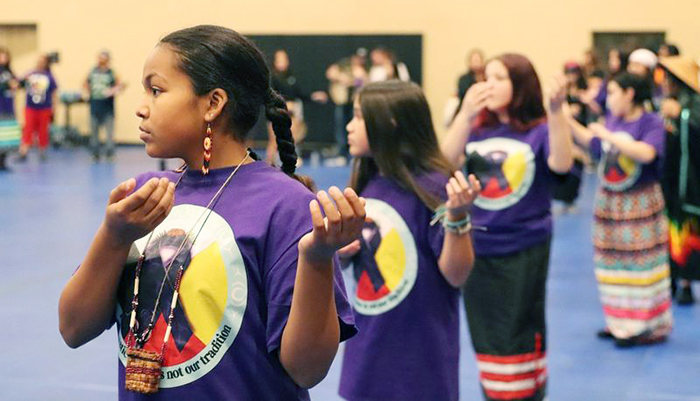
By Kalvin Valdillez, Tulalip News
Wow! Tulalip was treated to a fun and busy summer. The season was full of cultural enriching gatherings, such as the Salmon Ceremony, the annual Stick Games Tournament, Spee-Bi-Dah, and the Youth Canoe Journey. These were among many other community building events like the Pride Everyday celebration, the Back to School Bash, and the Health Clinic’s annual Health Fair.
With fall just weeks away, the Tulalip community is already in the midst of a change of pace and transitioning to what the Tribe is officially dubbing, the Season of Healing. Many of the events that will be held from now until the end of the year will be heavily focused on informing and supporting Tulalip’s membership and community about the impacts of generational trauma, and in turn, begin the healing process.
Secretary of the Tribe, Theresa Sheldon, shared, “The Tulalip Tribes Board of Directors support education and healing. We recognize that we may not see how the 75 years of the Indian boarding school that operated here in Tulalip still impacts our lives. As parents, as family members, and as community members of the Tulalip Tribes we are all still living in the consequences of federal assimilation policies. We have heard from the community the need to create safe places, create healthy conversations, and create a place of justice and healing. We hope the Season of Healing will begin this conversation and we hope to begin this hard work for our ancestors and for the next 7 generations to come.”
In addition to the handful of events that are a part of the Season of Healing, there are numerous other gatherings that you will want to keep on your radar throughout the next few months. We’ve compiled a detailed list of upcoming events, so be sure to mark them down on your calendars because you are not going to want to miss out.
- September 7 – Beginner Wool Weaving with Tillie Jones
- Where: Hibulb Cultural Center
- When: 10:00 a.m. – 4:00 p.m.
- September 9 – Weaving Love into our lives: Post Boarding School Era with Serene Thin Elk
- Where: Tulalip Gathering Hall
- When: Dinner at 5:00 p.m., Workshop at 6:00 p.m.
- *Please RSVP at: https://app.smartsheet.com/b/form/ce6877abd9f44c969fcfb6cbbb0719aa
- September 14 – Yarn Dolls with Melissa Gobin
- Where: Hibulb Cultural Center
- When: 1:00 p.m. – 4:00 p.m.
- September 16 – Our Traditional Foods Are Powerful with Lindsey Crofoot
- Where: Tulalip Gathering Hall
- When: Dinner at 5:00 p.m., Workshop at 6:00 p.m.
- *Please RSVP at: https://app.smartsheet.com/b/form/ce6877abd9f44c969fcfb6cbbb0719aa
- September 19 – Exclusive Tribal Member Hiring Event
- Where: 31st Ave. Campus, Suite C
- When: 10 a.m. – 2:00 p.m.
- September 21– Cedar Basket Weaving with Jamie Sheldon
- Where: Hibulb Cultural Center
- When: 1:00 p.m. – 4:00 p.m.
- September 23 – Mental & Physical Power Begins With Self with Sheldon Smith
- Where: Tulalip Gathering Hall
- When: Dinner at 5:00 p.m., Workshop at 6:00 p.m.
- *Please RSVP at: https://app.smartsheet.com/b/form/ce6877abd9f44c969fcfb6cbbb0719aa
- September 28 – Beginner Wool Weaving with Tillie Jones
- Where: Hibulb Cultural Center
- When: 10:00 a.m. – 4:00 p.m.
- September 30 – National Day of Remembrance
- Where: Tulalip Gathering Hall
- When: Dinner at 5:00 p.m., Workshop at 6:00 p.m.
- October 3 – Art Class at Hibulb with Ty Juvinel
- Where: Hibulb Cultural Center
- When: TBD
- October 4-5 – NW Native American Basketweavers 27th Annual Gathering
- Where: Tulalip Gathering Hall
- When: TBD
- October 7 – Learning to work through Loss & Grief
- Where: Tulalip Gathering Hall
- When: Dinner at 5:00 p.m., Workshop at 6:00 p.m.
- *Please RSVP at: https://app.smartsheet.com/b/form/ce6877abd9f44c969fcfb6cbbb0719aa
- October 10 – Art Class at Hibulb with Ty Juvinel
- Where: Hibulb Cultural Center
- When: TBD
- October 14 – Indigenous Peoples Day celebrating with Papahana Aloha Aina Hawaii
- Where: Tulalip Gathering Hall
- When: Dinner at 5:00 p.m., Workshop at 6:00 p.m.
- *Please RSVP at: https://app.smartsheet.com/b/form/ce6877abd9f44c969fcfb6cbbb0719aa
- October 17 – Art Class at Hibulb with Ty Juvinel
- Where: Hibulb Cultural Center
- When: TBD
- October 21 – Violence in Indian Country is not traditional
- Where: Tulalip Gathering Hall
- When: Dinner at 5:00 p.m., Workshop at 6:00 p.m.
- *Please RSVP at: https://app.smartsheet.com/b/form/ce6877abd9f44c969fcfb6cbbb0719aa
- October 24 – Art Class at Hibulb with Ty Juvinel
- Where: Hibulb Cultural Center
- When: TBD
- October 25 – Domestic Violence Awareness Month Coastal Jam
- Where: Greg Williams Court
- When: 6:00 p.m. – 10:00 p.m.
- October 25 – Tulalip Halloween Party
- Where: Tulalip Gathering Hall
- When: 5:00-8:30
- October 27 – Together We’re Better Trunk or Treat
- Where: Tulalip Boom City
- When: 3:00-5:00
- October 28 – Our Story Begins with Us
- Where: Tulalip Gathering Hall
- When: Dinner at 5:00 p.m., Workshop at 6:00 p.m.
- *Please RSVP at: https://app.smartsheet.com/b/form/ce6877abd9f44c969fcfb6cbbb0719aa
- October 31 – Art Class at Hibulb with Ty Juvinel
- Where: Hibulb Cultural Center
- When: TBD
- November 1- Coastal Jam Ballot Party
- Where: Tulalip Gathering Hall
- When: Dinner at 5:30 p.m., coastal jam and raffle to follow
- November 28 – Tulalip Tribes Thanksgiving Luncheon
- Where: Tulalip Resort Casino
- When: 12:00-2:00
- December 25 – Tulalip Tribes Christmas Luncheon
- Where: Tulalip Resort Casino
- When: 12:00-2:00
*Please keep in mind that all events, times, and locations are subject to change.*
Story pole returns to Quil Ceda Tulalip Elementary
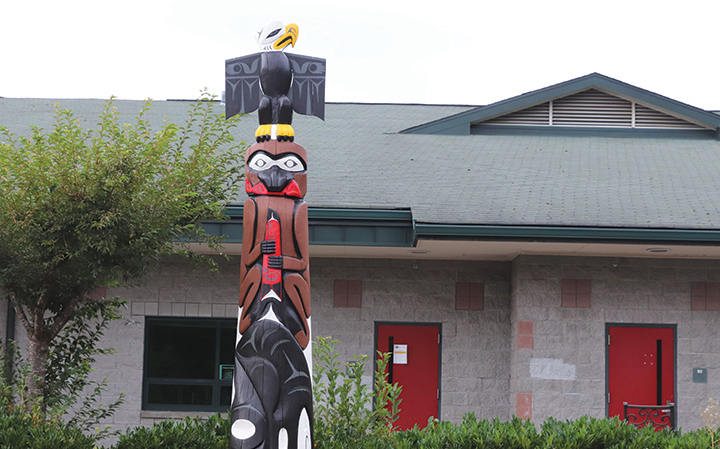
By Wade Sheldon, Tulalip News
When considering Indigenous culture, one of the most iconic representations is the story pole, often called a totem pole. On Wednesday, August 27, Quil Ceda Tulalip Elementary proudly reinstated its story pole, after being carefully restored by its creator, Lower Elwha artist Al Charles Jr. and students from Heritage High School. Standing over 15 feet tall, this striking piece serves as the school’s centerpiece, welcoming all who enter with its powerful presence and cultural significance.
Starting early in the spring, representatives of Quil Ceda Tulalip decided to revitalize the story pole, which has been part of the school since its inception. They connected with Foundry 10, an education research organization, and the Tulalip Foundation for help with funding. This collaborative effort underscores the community’s dedication to preserving and honoring its cultural heritage.
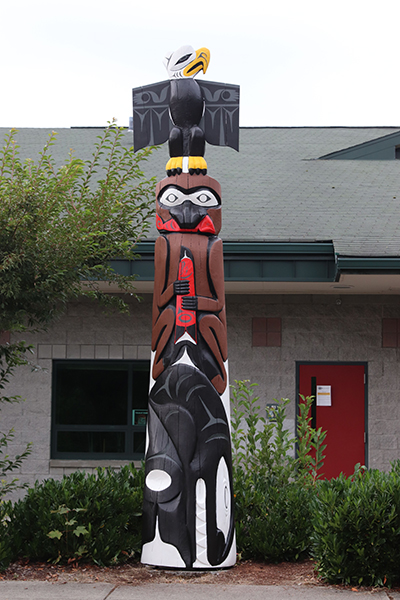
“The story pole has always been a significant part of our school,” said Vice Principal Dr. Chelsea Craig. “My child attended here when they were young, and seeing the pole every day as we arrived was incredibly inspiring. It was a daily reminder of our heritage and the stories of our ancestors.”
Dr. Craig emphasized the importance of cultural representation for the students. “Having such a prominent piece of our culture on display is powerful. Our students need to see themselves represented in the place where they learn. It instills pride in their identity and reinforces the value of our traditions.”
She continued, “The story pole means so much to us. It symbolizes who we are and what we stand for as a community. It’s not just a piece of artwork but a testament to our sovereign rights and enduring connection to our history and land.”
The beautifully restored story pole stands as a beacon of unity and resilience. Visitors to Quil Ceda Tulalip Elementary can see it proudly standing at the school’s entrance, symbolizing the rich history and values of the Tulalip people.
Connecting kids and cops through video games
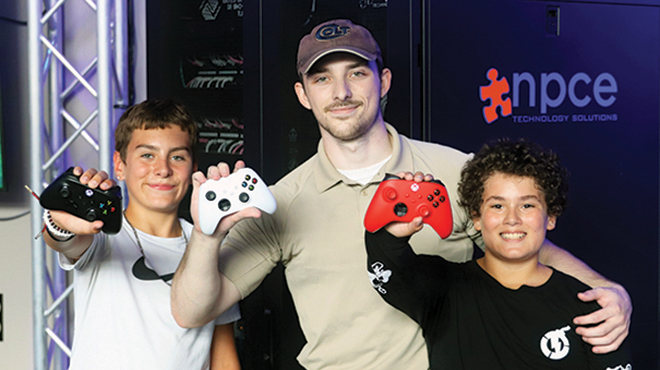
By Micheal Rios, Tulalip News
The video game landscape has undergone quite the evolution. From an overly dramatic, but somehow not that farfetched, idea that video games will rot a kid’s brain, to the culture-shifting news reported in July that e-Sports are set to take the Olympic stage in 2025. Yes, you read that right – video games are going to be an Olympic sport.

An official International Olympic Committee press release from July 12 reads, “A ‘first’ ever Esports Olympic Games are committed to a special event that respects and celebrates the Olympic values while boldly seizing the momentum to drive esports forward with the international platform the sport and its athletes deserve. The world will have an open invitation to join us in 2025 and celebrate this moment together.”
It’s easy to imagine a slew of parents shaking their heads in disbelief and thinking, “Yeah, well, video games can still rot a child’s brain. Olympic sport or not.” The thing is that’s simply not true. In fact, as reported by MedPage Today, a cross-sectional study found kids who played video games showed better cognitive performance than non-gamers. Specifically, those who played video games performed better on response inhibition tasks and working memory versus those who never played.

“Many parents today are concerned about the effects of video games on their children’s health and development,” said Bader Chaarani, Ph.D, a research professor at the University of Vermont. “And as these games continue to proliferate among young people, it is crucial that we better understand the positive impact that such games may have.”
One such positive impact is community building. For those in the know, video games have long since transcended their status as mere entertainment. They’ve become a significant social platform for kids and adults, alike.
In the digital era, people are more connected than ever before, and video games play a crucial role in this connectivity. A prime example of this connectivity and community building playing out in real time with real people was at the 2nd Annual e-Gaming Tournament. Hosted at our local Club, thirty-two teams representing all twelve Boys & Girls Clubs of Snohomish County and twelve local law enforcement agencies teamed up for an epic day of e-gaming.
Teams of three (two club kids and one law enforcement representative) battled it out during a competitive four-hour tournament. Their game of choice? The excitement fueled, arcade-style soccer game, Rocket League.
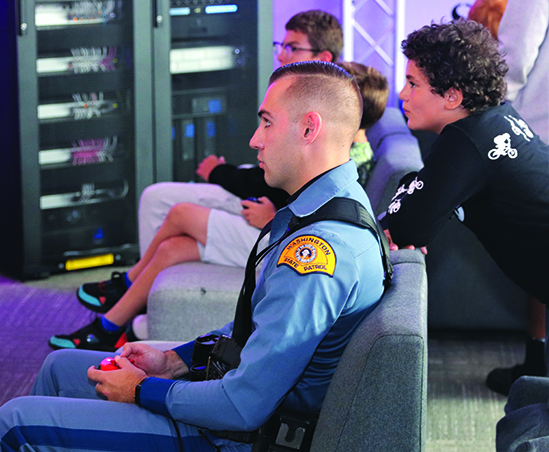
Competitors filled the Club’s teen center that’s become well-known for its plethora of gamer tech; an impressive internet bandwidth able to support supersized TVs, the latest Xbox gaming systems, high-end desktops with overclocked CPUs and graphics cards the size of small novels. Two of those TVs were dedicated to displaying an updated tournament bracket.
What started with 32 teams was whittled down round by round, through heartbreaking losses and literal jump for joy wins, until only two teams remained for an ultimate showdown. Teams that were eliminated early became spectators eager to see who would be crowned champion.
Prior to competing for the Championship, 22-year-old Lynnwood police cadet Cade Moren reflected on the day’s legendary potential. “The most exciting aspect of this tournament is it really shows how much video games can cultivate such a positive experience with law enforcement. Events like these really shows that collaborating with local police departments is such a worth while investment. How many seeds are being planted here that will grown into fantastic relationships in the future? Relationships that can only improve our shared communities and possibly have life altering benefits; such as kids who may go on to pursue a career in law enforcement because of this experience, or a cop who views a community differently because of a super cool interaction they had playing a video game with kid who reminded them of their younger self.”
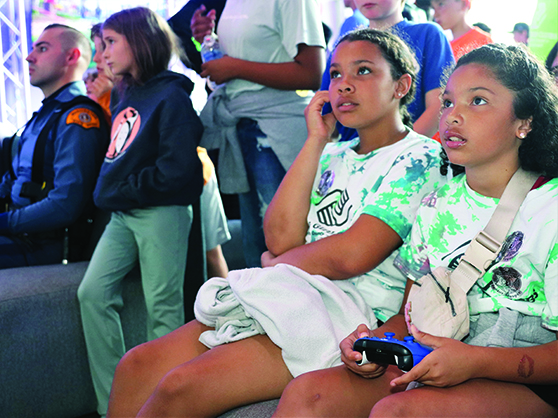
Expanding on what police cadet Cade so eloquently stated, video games are well-known conduits that attract players with shared interests. This creates a natural foundation for friendship. Kids and teenagers who might struggle with social interactions in every day, real life may find it easier to connect with others in a digital, online environment, where the focus is on a shared activity. For example, Tulalip youth living on their reservation may find support in gaming communities where they can express themselves more freely and connect with others who share similar experiences.
Twenty-six-year-old Jordan Jira isn’t too far removed from being that kind of Tulalip youth himself. Now, a Tulalip police officer, he still remembers that sense of community that came from unified purpose and simple fun. “I think this has been such an amazing experience for us officers and the kids. It’s something we can all come together, have fun in its purest form, and just make cool memories. The energy and excitement here in this building is kind of unmatched. It reminds me of high school sports and how fun it was to cheer on your favorite team or players. Like it should’ve been back then, it doesn’t really matter who wins or loses, all that matters is having fun.”

Jordan can also attest to just how far video game culture has evolved over such a short period of time. He admitted it feels like only yesterday his dad, TPD Sergeant Jeff Jira, wasn’t all that thrilled with video games, but now his dad actively cheered him on from as he navigating the digital realm all the way into the semi-finals. “He’s always been a real supportive father, so now its good to know he’s even supportive of video games, too. This is good practice for him because he’s going to be a grandfather again soon. Maybe this upcoming grandbaby has an Olympic gold medal in his future thanks to video games. Never know.”
Vying for a Rocket League championship, not a gold medal, ultimately came down to Team Everett vs Team Alderwood. Many oohs and ahs were generated by the crowd of spectators as they were treated to a highly contested match that went into sudden death overtime. Team Everett scored in the first minute of overtime and were crowned champions.
The winning team was comprised of City of Everett police officer Brandon Hoelzel, 14-year-old Aweys Hussein (Somalian) and 12-year-old Hamadi Rashid (Kenyan).
“My heart was pumping so hard every match. I was so nervous because it was my first time ever playing this game and didn’t want to let my team down. Now, that we’ve won it all, I’ll definitely be bragging about this for a while,” admitted Hamadi.
Scoring the championship-winning goal was officer Brandon. He said that not having known either of his younger teammates before it felt like he was playing with his younger brothers. “I enjoy playing video games in my free time. Usually I’m the one being humbled by my younger brothers, so it felt pretty good being the one to carry the team this time,” he joked. “Seriously though, it was a total team effort. After every goal and win, we’d celebrate with a high-five or fist bump. I definitely fed off their excitement.”

The collaborative nature of video games, such as Rocket League, brought together a super diverse field of competitors together. Kids and cops from different cities, neighborhoods, and ethnic backgrounds learned to communicate effectively, resolve conflicts, and work together to achieve their objectives. Interactions like these, as witnessed over and over again during the tournament, greatly promote a sense of empathy and understanding for others, especially as it relates to youth and the law enforcement officers sworn to protect them. Let us revel in the hope that beyond the thrill of gameplay, true community building took place in a safe space forged by video games.
Shawn Ledford takes the helm of Tulalip Police Department
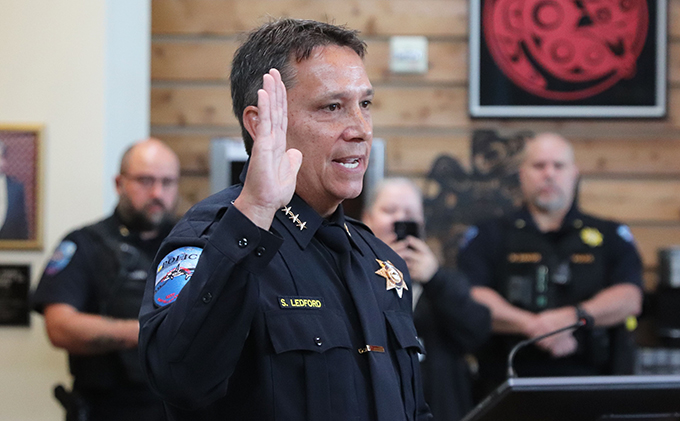
By Wade Sheldon, Tulalip Tribes
“It’s time to come home,” Tribal Chairwoman Teri Gobin told then King County Sheriff, Shawn Ledford, at a recent event. Fast forward to today, and the Tulalip people welcomed Ledford to the Tulalip Tribal Police Department. On Tuesday, September 3, Ledford was sworn in as Chief of Police. Ledford, a Tulalip tribal member, is stepping into the role previously held by Acting Chief Christopher Gobin.
Every member of the Board warmly welcomed Chief Ledford back to the community. Chief Ledford reflected on his decision to return: “When Chairwoman Gobin hugged me and said it’s time to come home, I felt something. I knew it was time. I always thought about it in the back of my mind. The timing was right, and hearing those words from someone I respect helped me decide.”
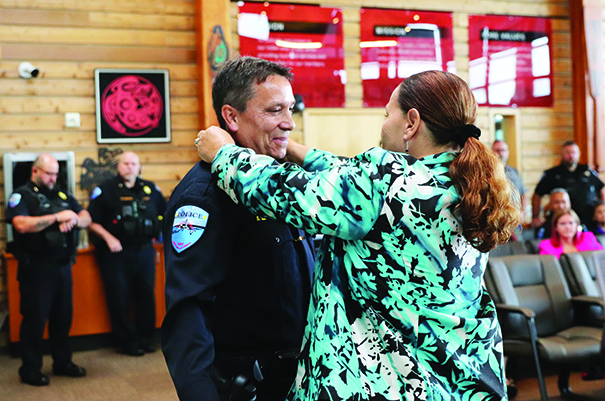
With 35 years of experience, Chief Ledford brings a wealth of law enforcement knowledge to his new role. He began his career as a patrol deputy at the Federal Way Precinct and quickly advanced through the ranks due to his extensive skills. His roles included hostage negotiator, detective in the Special Assault Unit, and then, Chief of Police for the City of Newcastle.
He furthered his career as Captain at the Southwest Precinct in Burien and then as Operations Chief at the North Precinct in Kenmore. In 2012, he was appointed Police Chief in Shoreline, where he served for a decade before being promoted to Division Chief with the King County sheriff’s office.
Marlin Fryberg, Tulalip Board of Director, emphasized the significance of bringing Shawn Ledford back to the community. Reflecting on the guidance from previous leaders, Fryberg shared, “Those leaders who were sitting on the Board then and are now gone, instructed me to watch for Shawn as he grew in law enforcement. They said to keep an eye on that young man, that tribal member of ours, because one day he will come home and help this community.”
Fryberg expressed his pride and optimism for the future, stating, “Ledford is home, and this is a good setting for all of us. When we say coming back home, you are home. You are one of us.”
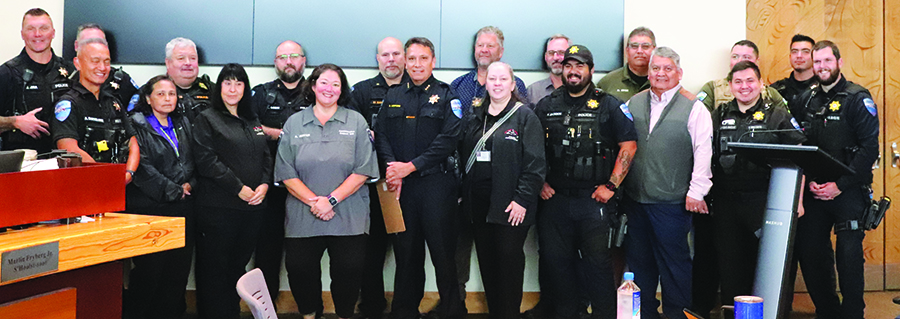
When asked what it means to return to the Tulalip community and serve, Chief Ledford responded, “It’s a great honor and challenge. I want to ensure I am doing right for our community—protecting and serving it passionately. Our focus will be keeping drugs and gang violence off the reservation.”
As Chief Ledford steps into this pivotal role, the road ahead will undoubtedly present its challenges. However, with his extensive background and deep family ties to the community, there is cautious optimism that his leadership will guide the Tulalip Tribal Police Department through these complexities, focusing on the safety and well-being of the Tulalip people.
Snohomish Warrior: Youth spirit captured on canvas

By Micheal Rios, Tulalip News
A year ago, then 11-year-old Tulalip youth Spencer Horne jokingly asked if he could have a cedar hat, a very specific cedar hat; one that belonged to elder Monie Ordonia. She would’ve gladly given it to him, but she couldn’t because it was gifted to her. The not at all bashful youth then asked if she could gift him something. To which Monie replied, “I’ll make you something special if you dance with all your heart for me.”
Dance Spencer did. He danced to Monie’s admiration whenever possible. He danced at Canoe Journey practice after Canoe Journey practice until, ultimately, he was dancing when the pressure was most intense, on Puyallup territory during Tulalip’s protocol.
“The real beauty of this process was we established a truly beautiful relationship that began with respect,” explained Monie. “Today, not many youth pay attention to that very important aspect, respect. It’s part of our teachings; treating others, especially elders, with respect. When you carry yourself in a good way, represent your tribe in a good way, then you show respect to not just your own family, but other families and other tribes, too.

“Spencer carries himself in a good way,” she continued. “He dances with his whole heart and when he sings, he sings as if his ancestors are listening. That means so much to me. As a creator, watching him, seeing him, and hearing him got me excited to create something that depicted my respect he had earned.”
What she created was a one-of-a-kind, from the heart painting that captured the essence of his and his fellow youth’s Salish spirit as she witnessed them rise and soar on the dance floor. Titled Snohomish Warrior, Monie gifted the finished product to the beaming with pride Spencer during the Tulalip Canoe Family’s post-journey celebration.
After unwrapping it and giving Monie the biggest of hugs, he casually strutted around the Gathering Hall offering all in attendance a glance at his long-awaited gift.
When asked what he sees in the painting, he responded, “I see me, my sister and my cousins. I like it. It’s powerful!”
And his message to his elder? “Thank you, Monie. I love you.”
August 31, 2024 syəcəb
Please the following link to download the August 31, 2024 issue of the syəcəb
The dance of plants and pollinators
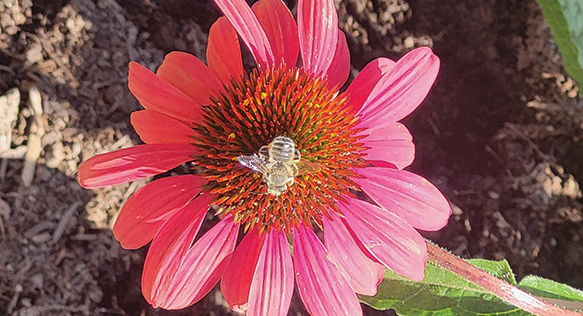
By Nathan Roberts, Wetland Technician, Quil Ceda Village
Quil Ceda Village Administration recently undertook a beautification project with new plantings along the front walkway. If you come to the Administrative offices, you’ll be able to see various grasses, spirea, primal-looking ferns, two young rhododendrons and many others. In addition to beautifying our workplace, many of these plants will attract and benefit pollinators. In fact, pollinators moved right in almost as soon as the plants were in the ground!
A pollinator is any organism which moves pollen from the male organ of one plant to the female organ of another plant, thereby instigating fertilization and seed production. With this, that means that pollinators play a critical role in the production of various culturally important foods, such as salmonberry (στəγʷαδαχ) and huckleberry (σωəδαʔξ̌). With the newly planted flowers joining their cousins in bloom this time of year, we tend to think of bees being the biggest help to fertilization of flowers and formation of fruits and seeds; however, there are many more pollinators than just bees. We have to thank not just bees, but birds, bats, butterflies, moths, flies, beetles, wasps and even small mammals for their contribution to native flowering plants and our food supply’s endurance.
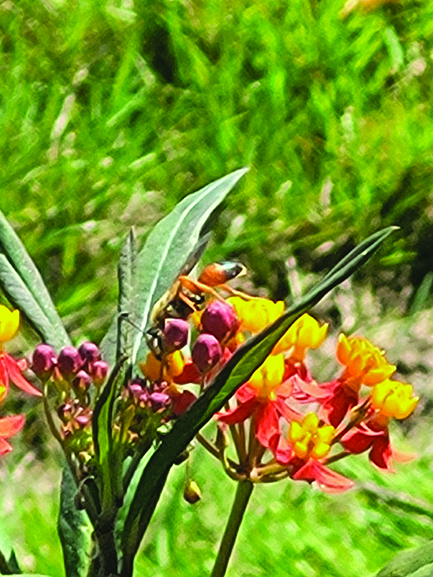
Tropical Milkweed.
We’re very lucky to call this state our home; a home we share with many species of native bees such as the cute Bumble Bee, the Blue Orchard Bee, the Western Leafcutter, the Metallic Green Sweat Bee and hundreds more. Many of the bees native to our state, about 70% of the 600 species, are what are known as “ground nesters”, meaning they might make their home under your feet rather than a hive above ground. Many of the pollinators you will see at our new plantings are ground nesting, some are also solitary. These pollinators use their mandibles to dig tunnels that can extend deep into the soil. At the end of these tunnels are small areas they nest in called “brooding cells.” Since most of these pollinators are solitary and dig deep underground, you can put your mind at ease about disrupting an underground hive.
Some of the flowers planted at Quil Ceda Village will particularly attract ground nesting pollinators. One of the first flowers to catch the eye are the two larger, planted Echinacea, or Coneflower. These are not just visually attractive to us, but to bees, butterflies and wasps as well with their vibrant colors and giant domed head, which makes for a perfect landing pad for many species. On these flowers, you might catch a glimpse of the Alkali bee, which is a ground nester and loves damp, silty soils such as that found at the garden of QCV. Another favorite of the local critters is the Tropical Milkweed, which is a delight for bees, but also Woodland Skipper and Monarch butterflies, and Great Golden Digger Wasps. With its long stems and small flowering bodies of golden yellow and red, it has a very sweet nectar that is a favorite among the crawlers. It should be noted that the Golden Digger species of wasp is classified as non-aggressive and is one of the before mentioned ground nesters, meaning they will not be seen creating hives in corners of the entrance and swarming as they are also solitary in nature. Plus, they prefer the nectar of flowers to human food.
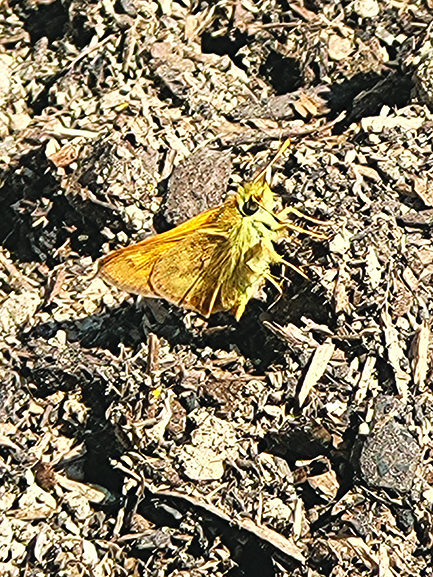
newly-applied compost.
But why should we care about whether or not our local bees are native or not? For a few reasons. With bees and butterflies in decline worldwide, planting pollinator-friendly gardens helps provide a stop-over and much needed foods to our local pollinators in areas that can be nectar and pollen deserts. Also, when invasive or non-native species are introduced to an area by humans or of their own accord, diseases are more likely to spread that the native populations have not encountered yet, leading to a possible drastic decline in numbers. Another reason is that native bees and other insects are highly responsible for the pollination of many of the beautiful flowering plants, such as those on display now at Quil Ceda Village, as well as native plants important for tribal foods and medicines. Native bees and other pollinators have special associations with our native flowering plants. Interestingly, the common Honeybee is not native to North America and was brought over by European colonialists. However, after hundreds of years of their pollination efforts, they are considered domesticated in the U.S. as they are essential for the growing of crops in the agricultural industry. In fact, according to the Bee Conservancy, while it is true that about a third of our food is grown thanks to honeybees, about 80% of flowering plants are pollinated with thanks to our native bees.
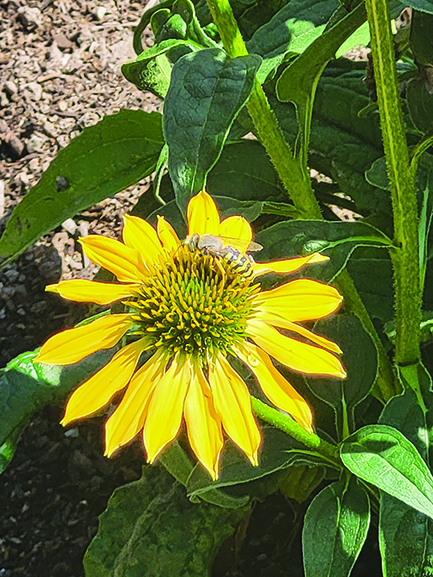
doing its part to help pollination.
This is all not to say that balance of pollinators and plants is invincible. One of the most devastating factors leading to the decline of native bees within the U.S. is the application of pesticides and insecticides. One of the immediate effects is of course, the reduction of insects that are essential to help the plants reproduce. However, a much darker effect is the scenario of insects bringing the poison back to their hives, where now other pollinators, or even a whole colony, could die. This is a less likely scenario for solitary pollinators; however, the more ornamental pesticide-treated plants there are in the world, the higher the number of these individual pollinators will die. Those who were born before the mid 90’s likely remember there once being a bounty of Western Bumble Bees in our state, however their numbers have been drastically declining since then and astonishingly, are now considered rare. Likely due to a combination of multiple factors, notably the competition with non-native species and disease, but their populations plummeting is certainly aided by the wrongful use of pesticides. This is why it is absolutely essential that there be more pesticide free zones, so that there can be areas for both plants and pollinators to prosper.
We are very fortunate to be able to live in a part of the world that is bountiful with life and green. The dance between plants and pollinators has been going on since time immemorial, and is beyond ancient. It is therefore imperative we do not lose sight of the delicate balance that all life depends upon so that our future generations may thrive in a world alongside plants and the creatures that pollinate them.
Greenhouse restoration underway at MPHS
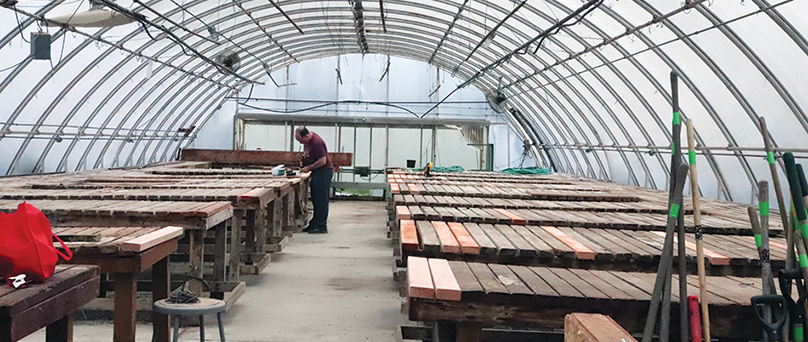
By Wade Sheldon, Tulalip News
The long-abandoned greenhouse at Marysville Pilchuck High School, unused for the past 15 years, is being revitalized for the start of the 2024-25 school year as part of the MPHS Greenhouse Project. It all started when a few teachers, including Biology teacher Kayla Carter and Head of the Science Department Claire Luvera, walked by the neglected lot and thought, “Why is this land just going to waste?” This question inspired Kayla and her colleagues to bring the greenhouse back to life, seeing it as a valuable resource for students and the community.
Kayla and Claire took the issue to the school administration, who approved their plan to clean up the greenhouse. This was no small task, as the greenhouse had been an eyesore on the MP campus for over a decade. Undeterred, they gathered tools, secured funding, and rallied support through community donations. Blackberry bushes had overtaken the buildings, walkways, and even the inside of the greenhouse. The monumental undertaking began at the start of summer, clearing the overgrown foliage, removing debris, digging out walkways, and bringing in an electrician to get the building operational.
Inspired by this potential, Kayla Carter, who was in her first year at Pilchuck, saw an opportunity to transform the space. “From my classroom, I could see this big greenhouse and land,” she said. Motivated by what it could become, Carter started the greenhouse project. “To get it going, we needed a lot of help from the community,” she explained. Initially, it was just her and another teacher working on the project, but the community’s response has been incredibly supportive. According to Carter, they’ve been offered tools, donations of lumber and compost, and a tree company helped trim trees.
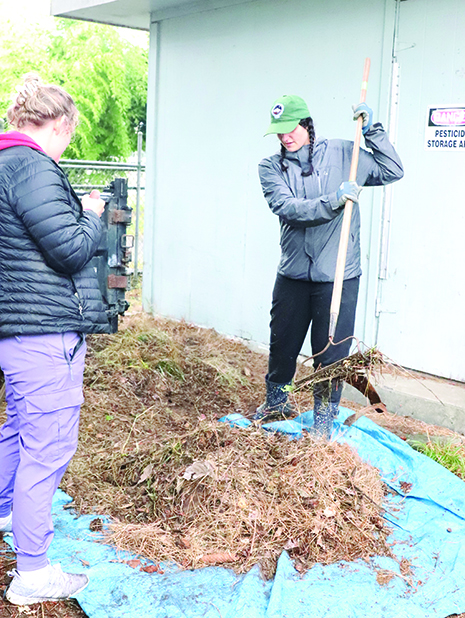
The plan is to form a garden club to maintain everything, and involve students in activities like testing water and soil, and growing different plants in various areas. Carter said, “The garden club will sell flowers and, hopefully, tomato starts for the program,”
For Carter, this project is about more than just gardening; it’s about bringing kids outside and connecting them with nature. “Some kids these days don’t go outside enough,” she said. She hopes that by having students grow plants they helped start, they will enjoy getting their hands dirty and seeing nature up close. “One of my dreams is to have students eat what they grew,” Carter shared, emphasizing her desire to have the students experience the entire cycle of growing and enjoying their food.
Luvera expressed enthusiasm for the new project and its potential impact on the curriculum. “We will be able to do so many labs and hands-on activities in all our life sciences,” she said. She explained that the decision to start this initiative was made earlier in the year. “Back in April, we looked around and decided to work on this project,” Luvera recalled. Her excitement for the future is apparent, especially regarding increasing student engagement through practical learning. “I am excited to get more hands-on activities for the kids,” she added. Luvera also shared her hope to revive an agriculture program, which would provide even more opportunities for experiential learning.
Eliza Davis, a member of the Marysville School Board, has been actively involved in supporting positive initiatives within the district. “I reached out to different organizations,” she said, explaining her efforts to find support for the greenhouse project. As someone deeply familiar with the challenges and negativity within the district, Davis wanted to focus on something positive happening in the schools.
“While on a tour, the Principal of MP, Peter Apple, told me about some teachers interested in getting this program going again,” Davis explained. Motivated by this opportunity, she connected with a few organizations and the non-profit Best Schools Marysville, which is dedicated to restoring schools in the community. The organization was eager to help and donated money to support the program.
Davis recalls that the program was once award-winning, with students making wreaths for Christmas and growing flowers for Valentine’s Day and Mother’s Day. “There are lots of opportunity for students to learn about business and practical, real-world skills,” she said. She is enthusiastic about seeing passionate young teachers. “It’s nice to see young teachers come in and want to change the culture and rebuild the program,” Davis added, reflecting on the potential for growth in the district.
The greenhouse project will continue throughout the school year, with plans to turn the greenhouse back into a functioning classroom. The district will decide later in the year whether to reopen the class. In the meantime, Carter and her team are hopeful for ongoing community support and involvement. For more information and updates, visit their Facebook page, MPHS greenhouse project.
Tulalip Foundation hosts 6th annual Salmon Bake Fundraiser
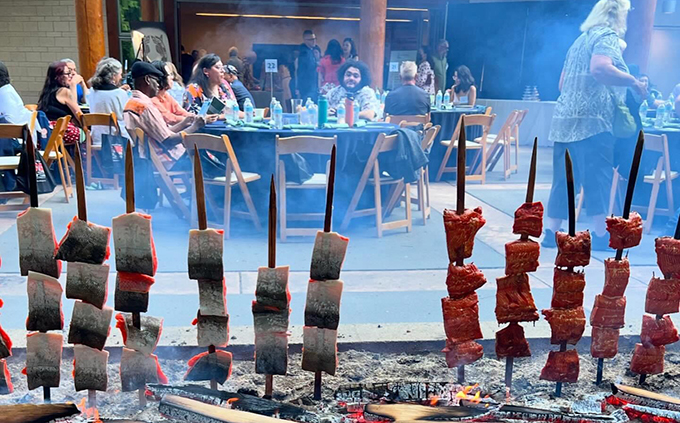
By Kalvin Valdillez, Tulalip News; photos courtesy of Nicole Sieminski, Stephanie Cultee and Tessa Campbell
A record breaking $70,000 was raised during the Tulalip Foundation’s Annual Salmon Bake Fundraiser benefiting the Hibulb Cultural Center. It was the hot ticket event of the summer and sold out during the week leading up to the gathering. Close to 250 people were dressed to the nines on the evening of August 17, as they convened at the cultural center’s terrace where they were greeted by the welcoming aroma of traditional baked salmon.
“Our ultimate goal is to support the cultural center and to feature it’s work and all the good work that it’s doing,” expressed Nicole Sieminski, the Tulalip Foundation’s Executive Director. “It is gratifying to see people’s support and that they keep showing up for us. And we’re grateful that we keep getting new supporters as well. My goal is to keep growing, which we did by a lot. We raised $52,000 last year, which was big because it was the first time we broke $50. And this year we raised $70,000!”
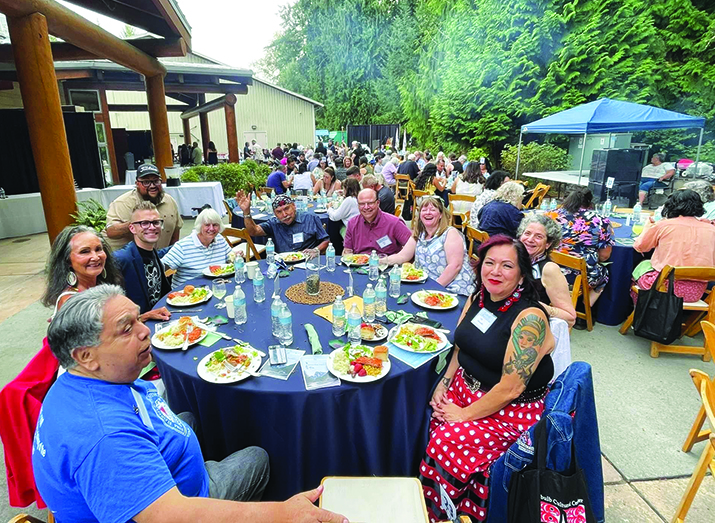
Since its establishment, the Hibulb Cultural Center has imparted a vast amount of knowledge about the Tribe’s history and ancestral teachings to the wider community. With historical artifacts, photos, and documents, the center has provided insight and a tribal perspective on issues such as colonialism and assimilation while simultaneously celebrating the ancestral teachings, values, beliefs, and stories of the Tulalip people.
Many of the cultural center’s gatherings, exhibits, and workshops are possible due in large part to the Tulalip Foundation’s annual salmon bake fundraiser. This is an all-hands-on deck event and is organized not only by the Foundation, but also the team from the cultural center.
The Tulalip Foundation is a non-profit organization that supports tribal programs and projects based on five support areas – culture and natural resources, education and workforce, law and justice, community and development, and health and social. The Foundation has made a great impact on the tribal community and has become well-known throughout the region. Many local companies and nationwide corporations have donated thousands of dollars for the betterment of both Tulalip’s governmental programs, as well as community-led and focused projects.
Making their sixth consecutive return to the event, the Taylor Family once again prepared the salmon over fire. What makes this special is that the people get to see this traditional method of cooking in real time. Attendees witnessed an act of passing knowledge to the next generation, as Lance Taylor guided his grandson Jared throughout the entire process.
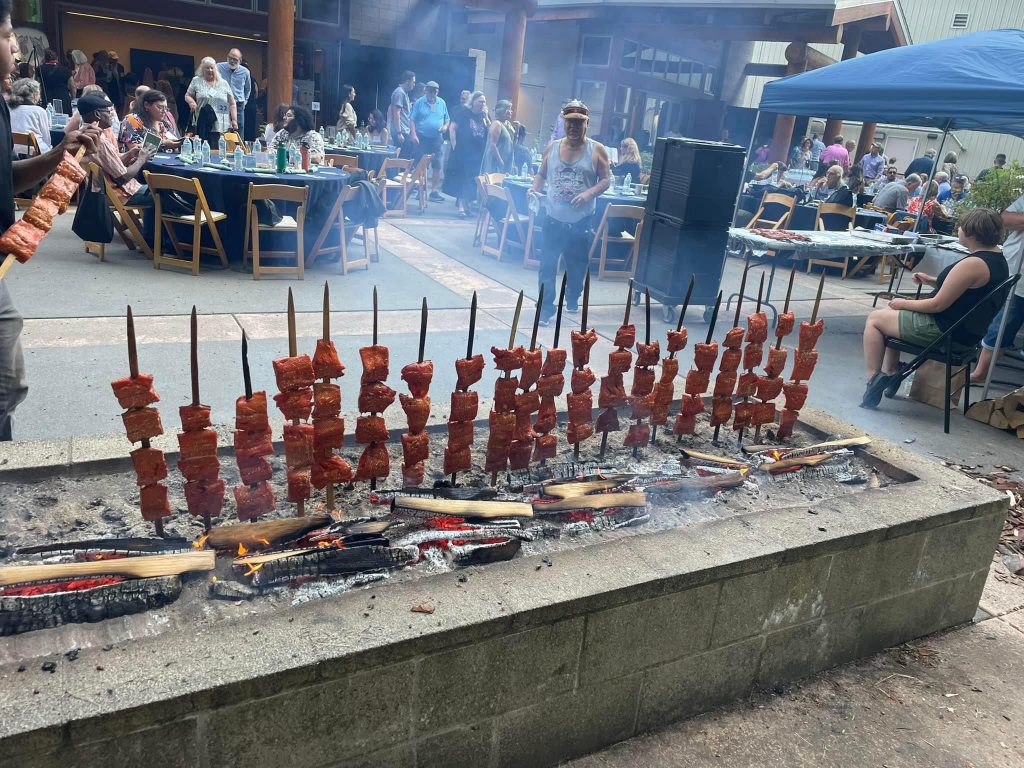
Ryan’s Rez-ipes, renowned for their delicious eats, was the official caterer for the event. And there were 22 sponsorships in total this year. Nicole shared that there were a few new sponsors, who have active contracts with the Tribe, that showed their support to the community including Korsmo Construction, KPFF Engineers, and the Wenaha Group.
While the food was being prepared, the guests were invited to tour the cultural center’s exhibits and gift shop. This was also the time to peruse the items that were up for bid at the silent auction. Rows of tables displayed artwork and regalia that was donated by nearly 30 Tulalip artists. Beside each donation there was an informational note, detailing the art piece and the artist, as well as a sheet of paper where the guests could place their bids.
“It’s always nice to see everybody’s work,” shared Nicole. “One that I loved this year was made by Jose Roja, who is a Tribal youth. He made his first traditional wool skirt and matching headband. Since it was his first one, he’s supposed to give it away, so he donated it to us to put in the silent auction. We actually had several Tribal youth who donated items for the silent auction, that was really cool to see our youth participate and show their support.”
Once the silent auction placed a last call for bids, the event began with an opening prayer by Natosha Gobin and the presentation of colors by the Tulalip Honor Guard. Young Tribal member Lizzie Mae Williams shared a traditional story, followed up by opening remarks from the Hibulb Cultural Center’s Museum Manager, Mytyl Hernandez.
DJ Monie was behind the turntables and helped set the vibe of the soiree throughout the night. As the attendees enjoyed their fresh king salmon dinners, they were treated to a live spoken word and flute performance by Renee Roman Nose and Peter Ali.
From the comfort of their seats, the guests could scan a QR code, where they could donate to a canoe restoration project via their smartphones. They also had the chance to enter in a drawing to win a canvas painting by Tulalip artist, Ty Juvinel.
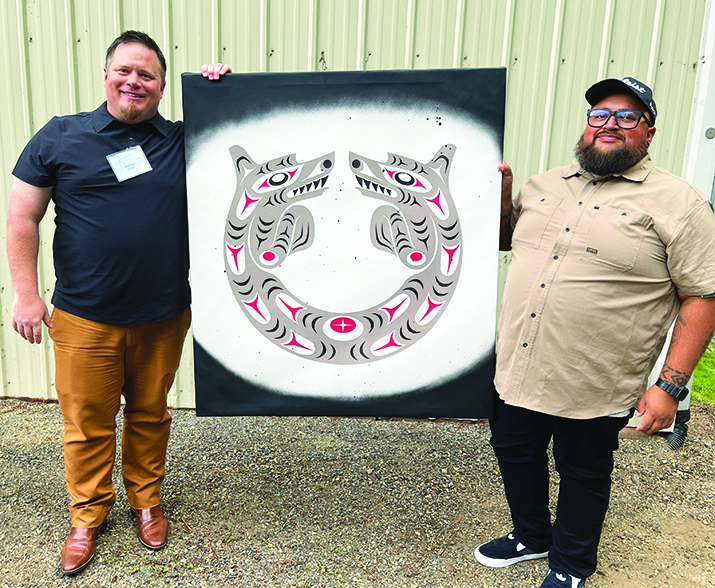
“This is the first year we did a specific fund a project,” said Nicole. “This was a canoe that was donated earlier this year that needs some serious restoration and treatment, it was outside for a very long time. Hopefully it will go on display in the canoe hall. This is a full-sized river canoe, the one in the canoe hall now is actually child sized. This is very similar to what we’d use here along our Snohomish, Stillaguamish, Skagit rivers. And Ty’s donation was great. We decided to use that for our special drawing. We always like to feature something unique for the special drawing. It was a very large print, almost 4ft x 4ft.”
This year’s fundraiser was dedicated in memory of David Spencer Sr., who was an active participant in countless events at the Hibulb Cultural Center for many years, notably at the annual film festival and the salmon bake. And according to Nicole, David also voices the introduction video that plays inside of the cultural center’s longhouse as people tour the museum.
Once everybody collected their winnings, the 2024 Salmon Bake Fundraiser was officially marked as a success in the books.
“I am extremely grateful for everyone’s support from friends, community, tribal partners,” Nicole stated. “Hopefully it means we’re doing our job well and showing them how the cultural center is continuing to serve the community. Every year the funds are going to future exhibitions and programming. Thankfully, the cultural center staff are able to continue to offer events. They just released their September events, and they have a busy schedule. It’s good to see that and hopefully our donors can see that as well.”
For more information, and to stay up to date on the Hibulb Cultural Center’s events, exhibits, and activities, be sure to give their Facebook page a follow. And for addition details about the Tulalip Foundation, please visit www.TulalipFoundation.org.